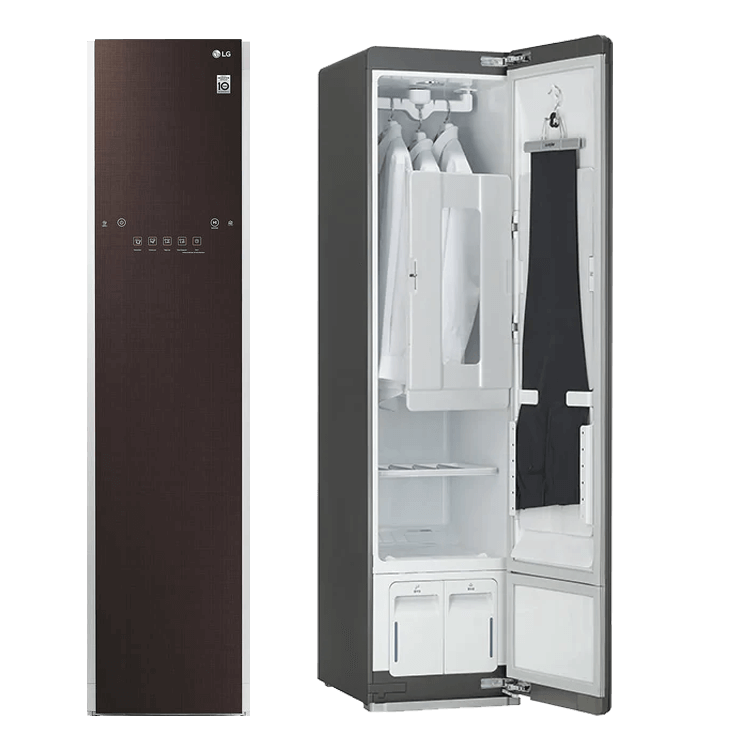4,9
Note moyenne
100 % des personnes qui ont reçu l'appareil ont donné leur avis, avec une note globale moyenne de 4,9 étoiles
LG UK soutient ses lancements de produits en affichant des avis sur les pages de ses produits sur les sites de ses distributeurs avant même leur sortie en magasin.
Lorsque LG UK a lancé LG Styler, un système de placard innovant qui assainit les vêtements et les garde au frais, la marque avait besoin d'inspirer suffisamment confiance aux consommateurs pour qu'ils achètent cette nouvelle gamme de produits haut de gamme. « Lorsqu'on se lance dans une nouvelle catégorie, il est essentiel que le consommateur perçoive le nouveau produit avec confiance, » explique David Hall, responsable du numérique chez LG.
« Les avis d'autres consommateurs sont un excellent moyen d'inciter cette confiance, parce qu'ils représentent une évaluation ouverte et sincère de la part d'utilisateurs réels de ce nouveau produit. Lorsqu'il s'agit également d'un nouveau produit ou d'un nouveau concept pour le marché, les premiers avis sont encore plus importants, parce qu'ils montrent aux autres consommateurs comment le produit peut s'intégrer dans leur vie de tous les jours. »
Sachant que les contenus authentiques des consommateurs jouent un rôle essentiel dans l'essai de nouveaux produits, notamment pour les articles haut de gamme comme ls gros appareils électroménagers, LG a fait appel à Bazaarvoice pour mettre ses nouveaux produits entre les mains des consommateurs et recueillir des contenus générés par les utilisateurs (CGU). Cela a permis à LG de publier des avis sur ses pages produits sur les sites de ses distributeurs principaux avant m^me que ses appareils ne soient disponibles à la vente dans les magasins physiques.
Il suffit de quelques avis pour faire toute la différence
Les consommateurs peuvent hésiter à acheter des produits niche coûteux si aucun avis n'est disponible. C'est pourquoi même quelques avis peuvent avoir un impact considérable sur les ventes.
« S'il s'agit d'un produit totalement nouveau sur le marché, un ou deux avis peuvent suffire à fournir un retour d'information 'authentique' aux consommateurs potentiels. Ils leur montrent à quoi ressemble réellement le produit et ce qu'il peut apporter à leur foyer, et ce à partir d'une source indépendante qui ne se contente pas de copier une fiche technique ou les informations fournies par LG, » explique M. Hall.
LG a envoyé le Styler à des membres très ciblés de la communauté de Bazaarvoice Sampling, et 100 % d’entre eux lui ont donné leur avis. Les 10 avis recueillis ont généré une note moyenne globale de 4,9 étoiles.
Parce que son site n'est pas commercial, l'objectif de LG était d'augmenter les achats auprès de ses distributeurs comme John Lewis. Actuellement, la majorité des avis publiés sur le site de John Lewis sont le résultat de campagnes d'échantillonnage et de syndication d'avis. Pour l'ensemble de la gamme de produits LG UK, la syndication représente 50 % des avis chez ses distributeurs britanniques. En d'autres termes, la moitié de ses produits de feraient l'objet d'aucun avis si la marque ne les encourageait pas activement.

L'échantillonnage permet d'obtenir des contenus de haute qualité
Pour les produits auxquels les clients réfléchissent beaucoup avant d'acheter, la qualité des avis peut être tout aussi importante que leur quantité. Les avis soumis dans le cadre du programme Bazaarvoice Sampling étaient très détaillés, chacun ayant pris le remps de se prononcer sur chaque aspect du produit, qu'il s'agisse de son efficacité, de sa facilité d'utilisation, de sa conception ou de son niveau sonore. Les avis comportaient en moyenne 1 400 caractères.
La majorité des avis comprenaient aussi des photos du Styler dans le domicile du destinataire.
« Les CGU qui accompagnent les avis sont très utiles. Les photos et vidéos des consommateurs qui montrent le produit en cours d'utilisation renforcent l'authenticité des avis. Elles permettent aux consommateurs potentiels de se projeter dans une 'vraie' maison plutôt que de se contenter des images soignées générées par LG, » poursuit M. Hall.
Les avis de qualité apportent également à LG des informations plus pertinentes. Un avis a par exemple mentionné que leurs feuilles de parfum qui peuvent être insérées dans le Styler donnent une bonne odeur aux vêtements, mais qu'il est difficile de trouver où en acheter de nouvelles sur le site de LG. Le câble du Styler était aussi trop court, ce qui rendait son branchement difficile.
Ce type d'information est essentiel pour permettre à LG d'apporter des corrections pertinentes à ses descriptions de produits et de créer des opportunités de vente croisée.
4,9
Note moyenne
100 % des personnes qui ont reçu l'appareil ont donné leur avis, avec une note globale moyenne de 4,9 étoiles
À propos de l'entreprise
LG Electronics Inc. est une multinationale spécialisée dans l'électronique.

S'il s'agit d'un produit totalement nouveau sur le marché, même un ou deux avis fournissent un retour d'information « authentique » aux clients potentiels. Ils leur montrent à quoi ressemble réellement le produit et ce qu'il peut apporter à leur foyer.
David Hall
Responsable du numérique chez LG
